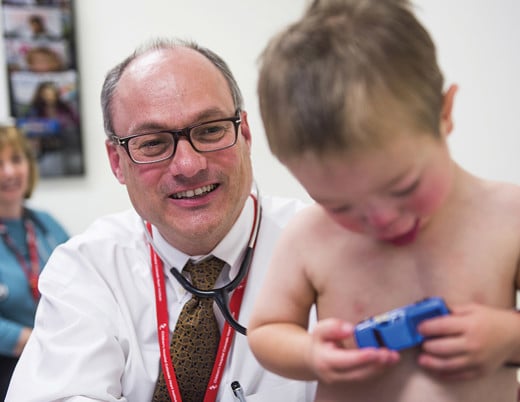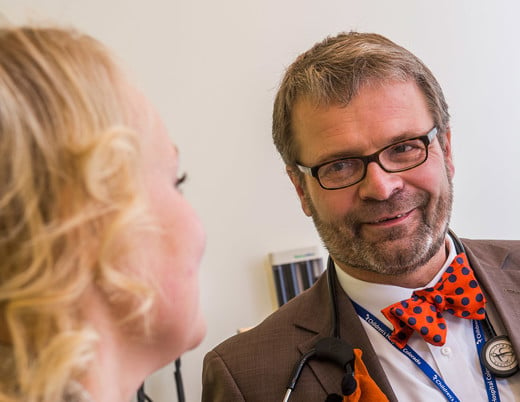Could a systematic team effort drive down cardiac arrest rates in the CICU?
In 2017, a group of investigators in the Pediatric Cardiac Critical Care Consortium, or PC4, looked at retrospective cardiac arrest data from more than 15,000 cardiac intensive care unit encounters. Their findings on outcomes were startling: The survival rate for patients who did not have a cardiac arrest in the CICU was about 98%. For patients who did have a cardiac arrest in the CICU, that number dropped to 53.2%. Pediatric cardiologist Carly Scahill, DO, MSCR, and nurse practitioner Kimberly DiMaria, CPNP-AC, took notice.
“It made us aware of how important cardiac arrest prevention is, not just for morbidity, but for survival,” Dr. Scahill says. “It also made us dig into our own data to see where we were.”
Knowing where they stood felt particularly important for Dr. Scahill, DiMaria and the team at Children’s Hospital Colorado’s Cardiac Intensive Care Unit. They, too, were members of PC4, a national collaborative of centers dedicated to clinical data-gathering and continuous improvement. But the first look was a painful one.
At the time of the paper’s publication in Pediatric Critical Care Medicine, the national average of cardiac arrests within CICUs was 4.8 per 1,000 patient days. Children’s Colorado’s average was closer to 5.5, and it was climbing.
“We knew we needed to figure out why,” Dr. Scahill says.
Linking up efforts
At the time, the team already had several measures in place related to cardiac arrest. They had a strong simulation program and a strong nurse education team, and they’d already begun implementing PC4’s cardiac arrest bundle.
“There were pockets of work around how to respond to these events but not actually how to reduce the rate,” says DiMaria. “The data was a call to action.”
Dr. Scahill and DiMaria brought together a group of a dozen team members to figure out a plan: the Cardiac Arrest Reduction and Excellence (CARE) program, aimed at both improving resuscitation response and minimizing the incidence of cardiac arrest. That effort has since grown to nearly 40 team members spanning the CICU and the cardiac step-down unit.
The process starts with debriefing every event and issue with the entire CARE team, which includes representatives from every ICU discipline, from pharmacists to fellows to respiratory therapists. Together, they evaluate what could have gone better and then devise education programs, simulations and process changes to improve the situation next time.
“And we send out a dissemination flyer afterward,” says Dr. Scahill, “which lets every member learn the lessons that came out of the debrief, even if they weren’t involved in the code.”
CARE program in action
In 2019, a code went south when CICU team members couldn’t locate an essential piece of emergency equipment: an intraosseous access device, most often used by emergency medical clinicians and field medics when intravenous access isn’t possible. The device had recently been moved, but the debrief also revealed that many team members not only didn’t know where it was, but they also weren’t comfortable using it.
In response, the team created education programs. They got a simulation going. They set up skills days and built opportunities for hands-on experience. Nurses rolled through the unit and did refreshers. They found a new, more prominent location for the device — a big yellow box — and told everyone where it was.
“Within weeks, a team needed to place the same access, and they could locate the device and place it, and the patient was resuscitated,” says DiMaria. “That’s both lifesaving for patients and empowering to the team, and it reinforces the importance of debriefing events and fixing issues as they come up.”
The power of the fix
Since getting off the ground during the height of the COVID-19 pandemic last year, the CARE program has posted impressive results. The team has started a quarterly lecture series that breaks down data from each cardiac arrest event and illustrates takeaways. They’ve created a CARE coaching role and recruited a handful of team members into it. And they’ve put together several new simulations and trainings.
“The interventions themselves are not necessarily novel,” says DiMaria. “It’s that we’ve taken all these different ideas and made a comprehensive, integrated program that’s designed for the needs of our unit.”
And it’s worked. Sixteen months out from implementation, Children’s Colorado’s CICU has reduced its rate to 4.16 per 1,000 patient days, a reduction of 25%. The rates and averages, as assembled by PC4, fluctuate from day to day, but at times Children’s Colorado’s rate has been the lowest in the nation.
“Never underestimate the power of fixing what the team says is broken,” says DiMaria. “That’s our motto.”
The six arms of CARE
Dr. Scahill, DiMaria and the team designed the CARE program with six basic pillars that strengthen and reinforce one another:
- A three-tiered in-situ simulation program to practice high-risk, low-frequency emergency skills and reinforce team dynamics
- Resuscitation-focused educational forms to improve recognition of early signs and increase awareness of best practices
- A comprehensive cardiac arrest prevention bundle
- A formal code debriefing process
- Dissemination of code-related updates to team members in the form of flyers, a lecture series and bedside visits
- A resiliency program to increase work satisfaction and belonging and decrease burnout
Featured Researchers

Carly Scahill, DO, MSCR
Co-Director, CICU/CPCU Resuscitation Improvement Team
Fellowship Director, Advanced Cardiac Critical Care
Children’s Hospital Colorado
Assistant professor, Pediatrics-Cardiology
University of Colorado School of Medicine
Kimberly DiMaria, CPNP-AC
Pediatric critical care nurse practitioner
Children's Hospital Colorado





 720-777-0123
720-777-0123










